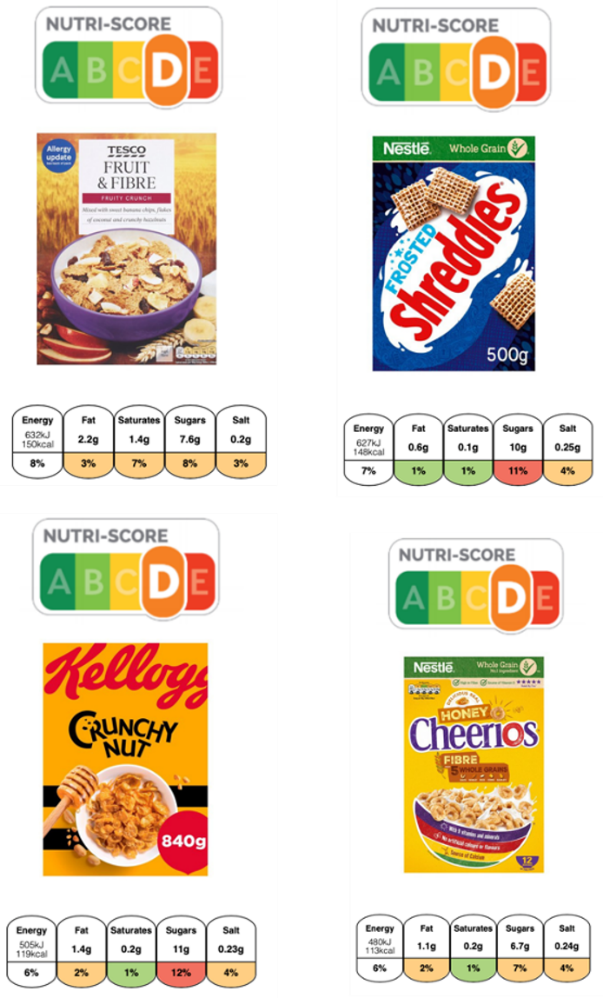Q1-5 for Businesses
Although not a business, the BDA represents dietitians working across the public and private sectors and as such has some specific responses to these questions.
The Association strongly believes that government needs to undertake its own independent audit and collect its own data on use of the traffic light labelling scheme. The work undertaken by Kantar that is frequently cited in this report does not appear to have been published nor made available for scrutiny. Relying heavily on companies to provide their own data is likely to require much coordination and will not be independently collected. This will hinder the process of independently verifying and evaluating the penetration and impact of FOPNL on UK products.
Equally, government should be undertaking its own independent evaluation of reformulation of industry’s product reformulation initiatives, including as a result of FOPNL declarations, as part of its wider reformulation work. This should be used to inform our understanding of existing reformulation, rather than relying on companies to provide that data.
Q6 Do you use the Multiple Traffic Light label to make choices about the food and drinks that you buy?
There is currently mixed evidence with regards to the impact of the current UK MTL on consumer food choices, purchases and consumption, in part because of a lack of research. A recent survey by the British Heart Foundation, not currently published but commissioned for this consultation, found a mixed result amongst those asked whether they used FOPNL when making food choices, with 11% reporting that they ‘Always’ did, 22% saying ‘Often’ and 30% ‘Sometimes’.
We would argue that further consistency would make these labels more effective. Although the Food Standards Agency has published FOPNL guidance[1], it still allows flexibility on fonts, colours (or lack thereof) and choice around portion sizes. The Association believes we need to have one scheme and a mandated format for all FOPNL.
It is also clear that any form of labelling will not be successful without an accompanying consumer education campaign. Whichever form of front of pack labelling is introduced, it should be done so consistently, and backed up by a long term, national information campaign to ensure people of all ages are able to properly interpret the labels and how they can assist in choosing a healthy diet. Evidence shows that health literacy and label understanding should be important components of any such campaign[2].
It is clear that whatever approach is taken, labels on their own cannot provide sufficient information for customers to make fully informed choices about diet. Diets are not made up of individual food items, but a whole range of foods, including some that may be high in fat (particularly saturated fat), sugar or salt. FOPNL can be a part of a wider effort to provide information and education about healthy diet, as has been recognised by its inclusion in the 2016 Eat Well Guide.
Q7a Do you find the Multiple Traffic Light label clear and informative?
If properly formatted, of consistent size and used in a consistent way, we believe that the MTL label is both clear and informative, and its impact can be expected to outstrip back-of-pack nutrition labelling.
However, key issues with the FOPNL scheme at present concern manufacturers own serving size determination, which without standardization and consistency across products will present consumers with FOPNL information which is not comparable (like for like) on the front of pack.
Institute of Grocery Distribution (IGD) have produced clear guidance[1], based on consumer research, which outlines good practice for traffic light front of pack labelling. The IGD have identified issues with consumer and interpretation around FOPNL, specifically around ‘Reference Intakes’ terminology, which has also been identified elsewhere[2]. The BDA would encourage the use of explanatory text accompanying the ‘Reference Intake’ terminology to address this issue.
If MTL is made mandatory (as we believe it should be) we would strongly recommend a set of mandatory guidelines for the use of FOPNL setting out prescribed formats, fonts, colour etc. As previously mentioned, current official guidance provided by the Department of Health and Social Care and Food Standards Agency is insufficiently rigorous, as it does not set clear requirements for a standardised FOPNL. Instead, in line with EU Regulations, there are several options for manufacturers to choose from including energy only, with/without colour, or nutrients plus energy. We need to ensure the proposed changes are not a missed opportunity to mandate and consistently apply labelling to UK food and drink products, with the intention of helping consumer to use them
Q7b How easy do you find the following components of the Multiple Traffic Light label?
Individual nutrients (fat, saturates, sugar, salt)
We agree with the usage of these four key nutrients, as they are recognized as key nutrients of public health concern where intakes are likely excessive relative to dietary guidance. These are easily understood by the public as nutrients that should not be consumed excessively as part of a healthy diet.
We are concerned that there remains inconsistency between the government’s public health messaging focused on ‘free sugars’ and the measure used nutrition labelling of ‘total sugars’. We recognise the technical difficulties of determining free sugar[1] content for both dietitians and manufacturers in many products, such as those containing fruit. Without differentiating between the two, and providing context through a consumer education campaign, there is scope for confusion.
We note that this section of the consultation has not asked for feedback on ease of use of the energy aspect of FOPNL, which is an important part of the label.
Use of red, amber and green colours
The use of colours is a clear means of identifying goods that may be high in fat (particularly saturated fat), sugar or salt and is well understood by the public. We are concerned that if again, as with is currently the case with many other elements of the labels, they are not applied uniformly, with some retailers choosing not to use colours then labelling becomes less clear. IGD research has found that consumers “prefer traffic lights to monochrome lozenges as they provide a “good shortcut to information”, are “more eye-catching” and are easier to compare.”[2] The same research also found that over 80% of consumers understand that red traffic lights do not mean food should be avoided entirely. This is encouraging and indicates they are not being used to label foods as ‘good’ or ‘bad’, and important consideration.
It is important that colours are not used with regard to calories, as this is often a key area of concern for those at risk of or living with eating disorders. By comparison, eating disorder specialists, including dietitians, have been able to use the colour coding of specific nutrients as a part of their approach in supporting dietary improvements, but only where they are used consistently. Inconsistent colouring or measurements used on labels make this more difficult.
Reference intakes
Consistent reference intakes across labelling is helpful, but only paired with a consumer education campaign to ensure that the public understands how their own intake might differ due to age, size and exercise levels. Current terminology, such as ‘% of an adults reference intake’ without context is not well understood by consumers, especially those with lower literacy or nutrition knowledge[3]. Research has shown that most people cannot correctly report the number of calories a ‘typical’ man or woman should be consuming each day, let alone their own needs[4]. This is why we believe the inclusion of explanatory text in FOPNL or on back-of-pack would be helpful.
This is also true when no detail is included on what constitutes an Adult’s Reference Intake in terms of calories, sugar, salt or fat. IGD research has found nearly half (46%) of shoppers feel that nutritional labels are too difficult to read, with reference intakes, portions and calorie amounts highlighted as particular areas of confusion[5].
We are concerned that all packaging, even products specifically aimed at children, use Adult Reference Intakes (if they are used). We understand that reference intakes for children are more difficult to create accurately due to the constantly changing requirements of a child as they age, but it may be helpful to use a different average measure for a child of a given grow, at least close to the target age of the product (e.g. infants for baby foods). We note that the previous Guideline Daily Amounts scheme did include values for children.
Portion size
The current flexibility around portion sizes is an area of significant concern. The ability to use either ‘per 100g’ or ‘per portion’ creates confusion, especially if someone is scanning a label quickly. ‘Per 100g’ offers consistency with more detailed information provided on back of pack and between products, but ‘per portion’ offers more realistic information on that individual product.
Industry’s ability to determine what constitutes a portion size also needs to end. A good example is the ability of well-known soft drinks firms to describe a single 500ml bottle of drink, almost always consumed in one sitting, as two portions. You see similar unrealistic portions described for packets of crisps, biscuits and other high fat, sugar and salt products in an attempt to engineer an amber FOP label. We have particular concerns where advertising, promotions or even packaging clearly indicate a very different portion size to that suggested by labelling. Breakfast cereals are a good example of this.
When implementing a compulsory front of pack approach, government should create a standardised and mandatory service size/portion across foods. Portions need to reflect what is realistically eaten in one sitting. PHE have already undertaken similar work as part of the sugar/salt/calorie reduction programme, and there is no doubt learning that could be drawn from this. Similarly, we are aware that work in the US on the Nutrition Facts label now includes more realistic portion sizes based on what people actually eat[6]. It should be noted that the US approach specifically states that such portion sizes are not a recommendation of how much someone should eat.
[1] https://www.cambridge.org/core/journals/public-health-nutrition/article/definition-of-free-sugars-for-the-uk/2A2B3A70999052A15FD157C105B3D745
[2] https://www.igd.com/articles/article-viewer/t/front-of-pack-labelling-what-consumers-want/i/22181
Q8 How could the Multiple Traffic Light label be made easier to use?
Consistency is absolutely vital. As mentioned before, a set size, font and language would ensure those with lower literacy skills, for whom English is not a first language or with visual impairments are better able to understand the label content.
As also mentioned before, consistent use of either portion sizes (determined independently) or per 100g across all labelling would make it easier to compare products like with like.
Again, we would reiterate that these front of pack labels must be made mandatory and accompanied with a comprehensive communication and education programme to ensure they are understood. The BDA are disappointed that this consultation does not make any reference to helping consumer to use FOPNL or promote their use. Properly trained nutritional professionals, including dietitians will have a key role to play in any such campaign.
Q11 Do you think you would be likely to use one of these labels more when shopping, compared to current Multiple Traffic Light label?
The BDA strongly believe that the MTL approach should be used ahead of either of these alternatives. It is the best understood, and already exists on many products. A change to a totally different system, evidence for the effects of which is not entirely based o UK consumers, would be both costly and likely to lead to greater confusion. It would also waste the education which has gone before to support this approach.
Q12 What aspects of the Nutri-score label do you like/ dislike?
We appreciate that Nutri-score has good evidence behind it from its use in Europe. However, there is limited research from the UK context, and we would advise that this is needed before it could be considered for use in the UK.
Its simplicity is however both a strength and a weakness. While it is certainly easier to understand on first glance, it fails to take into account the full complexity of food in terms of nutritional content and health. Analysis by colleagues at Consensus Action on Sugar, Salt and Health (CASSH) highlights how products with significantly different nutrition profiles under FOPNL are given the same rating on Nutri-score. We include an example below in Fig 1. We also note that the underpinning colour coding criteria is based only on per 100g nor serving sizes which represents a further limitation.
Fig 1. Sample Cereals with MTL and Nutri-Score (produced by CASSH)

We are concerned that the Nutri-score approach risks sorting food into ‘good’ and ‘bad’ groups based on its colour. We believe it is important not to make value judgements about food types or groups or demonise certain foods. The aim should be to inform, not chastise consumers. We also believe that consumers should be provided with more unambiguous information, not less.
The use of different gradations of colour (e.g. light and dark green) also adds a further level of complexity that differs from the model widely used already within the UK.
Q13 What aspects of the Chilean health warning label do you like/dislike?
The BDA strongly opposes the use of the Chilean model. It is overly simplistic; labels need to provide information for consumer choice beyond simply stating that something is ‘high’ in a given nutrient or energy. This does little to help customers make informed choices. The consultation does not present the underpinning criteria for either model and how this would change the profile or score of a product already reformulated to UK MTL requirements.
The use of a stop sign shape also implies that such foods should be avoided, when it is accepted that a range of foods can form part of a healthy diet. We believe it is imperative to avoid an approach that creates a concept of ‘good’ and ‘bad’ foods, which make value judgements about food types or groups. The aim should be to inform, not chastise customers.
In particular we would be concerned by how such a system would impact on those at risk of or living with an eating disorder. Such individuals already have a challenging relationship with food, and such stark, uncontextualised labelling would only serve to make that more difficult. Specialist eating disorder dietitians work hard with individuals to encourage them to understand that no food is ‘bad’ and foods do not need to be avoided entirely. They seek to support a change in a person’s perception of foods to empower them to have a healthier understanding of the role of various nutrients in the diet. This labelling scheme would completely undermine that approach.
The only element of the Chilean model to be applauded is that it is consistent and mandatory.
Q14 Both Nutri-Score and health warning labels have been introduced in countries around the world. Can you provide any further evidence on the impact of these labels?
Research looking at recent studies on FOPL (post 2018) has found labels to be more effective than no labels in influencing consumer choice[1]. They also found that MTL was amongst the most effective, with Nutri-score and ‘higher in’ labelling also being effective. We would argue that if there is no significant difference in effectiveness between label types, it would make most sense to continue with the existing and established system of MTL. These studies also do not take account any potential harm from the ‘higher in’ approach to those at risk or living with eating disorders.
Q16 Do you think the Government should ensure that the recommended Front of Pack Nutrition label reflects latest dietary advice on free sugar?
We believe it would be positive to be consistent with the government’s health advice through programmes such as Change4Life. If it is to be considered, it will be important that PHE or a similar body provide tools to support all food and drink manufacturers to calculate and display free sugar quantities accurately in line with the definition used by PHE.
Q17 Do you think the Government should ensure that the Front of Pack Nutrition label reflects the latest dietary advice on fibre?
Although we agree that increasing fibre intake in the UK diet is important for health, we believe there is potential for confusion. All of the coloured elements of the traffic light system, as currently designed, highlight nutrients that when consumed in excess have negative consequences, with higher amounts always leading to an amber or red colouration rather than green. For fibre, the opposite would be true and a potential consequence would be greater consumer confusion over how to use FOPNL.
We would need to see the proposed format (as well as evidence on consumer understanding) of such a FOPNL ‘panel’ to see that fibre information was formatted sufficiently differently and understood and used correctly by consumers. For example, how would low fibre products which do not contain any natural fibre (but may well be an important part of a healthy diet) be labelled?
We believe that back of back should include fibre labelling in a consistent manner to inform consumers.
Q18 Do you think that Front of Pack Nutrition Labelling is likely to have an impact on people on the basis of protected characteristics?
Without specific measures in place to ensure that FOP labelling is consistently readable, and takes account of recommendations for children, it risks discriminating on the basis of age. This could be resolved by ensuring that font sizes and terminology enables people of all ages to read the labels more easily. Having a separate set of reference amounts for children on products clearly aimed at children would also reduce the risk of discrimination.
Similarly, ensuring consistent and simple language will reduce the risk that such labels are confusing to those with learning disabilities and / or low levels of literacy. Health literacy levels are associated with improved understanding and use of nutrition label information.
Although not a protected characteristic, we would also encourage the government to consider impacts on the basis of socio-economic status.
We would like to also highlight our concerns about the lack of Person First language in relation to obesity and overweight in the consultation document. We equally raise concerns about the links made between FOP labelling, obesity and COVID-19.




